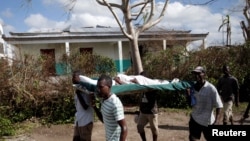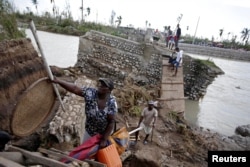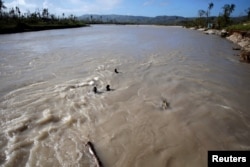Maria Auriviere lays on the floor of a darkened clinic, groaning against the pain of her twisted leg, yet to be treated after it was broken when Hurricane Matthew ripped into her Haitian village of Chantal three days ago, flattening homes and trees.
At least 86 people died in Chantal, 20 more are missing, Mayor Jean Max Charles said, making it possibly the place worst hit in Haiti by the storm, which killed at least 842 people and practically leveled villages clustered around the impoverished nation's western peninsula.
"We haven't seen anyone. There has been nobody but God," said her husband, Letori Fouquet, clutching a bottle of pain medicine he administered to try to relieve the suffering of his wife.
Her left leg was swollen, with the broken bone visible, and a bed pan filled with urine was beside her in the gloom.
"We don't have money. We don't have anything; we don't have a way out," he said at the clinic, where the patients who spilled out onto the sidewalk said no doctors or nurses had been seen since before the disaster.
In other nearby towns also, medical staff have not yet returned since taking cover from the storm. Contaminated water has already led to at least 21 cases of cholera in the area, seven of them fatal.
Chantal is nestled between green mountains on three sides, the only way in, and out, over a fragile wooden bridge impassable to the cars that wind up and down a dirt road form the nearest town, Les Cayes, the hub of this now devastated region that provides much of Haiti's food and export crops.
When the storm came, bringing 145 mph (233 kph) winds, villagers were trapped between water flooding off the hills and the raging river in front of the village of 3,600 people. Trees came crashing through the houses, some built of wood and thatch, some of concrete.
"There was no way to leave, there was water coming from all sides," said Alexis Jean Yvette, a student, who watched his neighbor's house collapse in the screaming winds.
Outside the clinic, about a dozen people took morning sun, waiting for care to arrive. Among them was Emmana Chateaulay, laid on a low cot with a wound on her head. She is about 75, her grandson said.
Julie Remy Rene, about 46, was hit by a coconut palm that fell through her roof while she was in bed. She was rescued by two of her children, one who was injured himself.
"We don't have anywhere to go now, because of all of our little houses were destroyed," corn farmer Remy Rene said, fretting about how she would pay back a 10,000 gourd ($154) government farm credit she used to set up her business. "What's most important now is we need doctors to help us."
In 2010, an earthquake killed up to 200,000 people, mainly around Port-Au-Prince. This time it is one of Haiti's most fertile regions that is hit, raising worries of food security in rural areas that just survived a drought.
Heifer International, a U.S. nonprofit working with more than 6,500 farming families in Haiti's south, said it expected a food crisis in the region within five months.
"The countryside was completely destroyed. We need food aid," Charles said.











